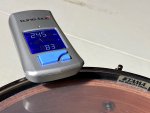Auspicious
Silver Member
So yeah, the establishment of DW is pretty anti-Tune-Bot ? and I understand the point.
But since I spent 125CAD on mine and I believe it's a very nice sensor, I have some question for people who like the Tune-Bot. I noticed the following things while doing my things.
- It's possible to test the heads with a mallet, a wooden stick or a something soft. I noticed that the wooden stick will often pitch much higher especially if the bottom head rests on a pillow.
- It's possible to tap a head when the bottom head is resting on a pillow but the reading are different from when both heads are free. Do you damper 1 head or do it on a mount both heads free to resonate? (Whatever the tunebot instruction, I already read them)
- Some people will put a finger on the head bellow and get the readings by tapping the head on top.
- Some people will put a finger on the top head, leave the head bellow unmuffled and get the readings.
Then there is the note itself, let's say I want to tune my snare to an A, all the lugs have a note on the Tune-Bot but the center of the drum has a different note, If I equalize all the lugs starting from the one I prefer the most, the center WILL have a different note then all the equalized lugs at the end.
- Even without a tune-bot, the note in the middle of the drum must be the final goal to achieve, right? In a sense that I need to reach the center note by ear, THEN equalize all the lugs, ignoring the note they produce, as long as they are equal and the note in the middle is equal to target. Is that right?
Feel free If you want to share how you use your tune-bot. I already read the complete instruction on the website, tried the calculator and looked at the various disappointing Youtubes videos. I am interested in what YOU are doing and your own technique, you own interpretation.
But since I spent 125CAD on mine and I believe it's a very nice sensor, I have some question for people who like the Tune-Bot. I noticed the following things while doing my things.
- It's possible to test the heads with a mallet, a wooden stick or a something soft. I noticed that the wooden stick will often pitch much higher especially if the bottom head rests on a pillow.
- It's possible to tap a head when the bottom head is resting on a pillow but the reading are different from when both heads are free. Do you damper 1 head or do it on a mount both heads free to resonate? (Whatever the tunebot instruction, I already read them)
- Some people will put a finger on the head bellow and get the readings by tapping the head on top.
- Some people will put a finger on the top head, leave the head bellow unmuffled and get the readings.
Then there is the note itself, let's say I want to tune my snare to an A, all the lugs have a note on the Tune-Bot but the center of the drum has a different note, If I equalize all the lugs starting from the one I prefer the most, the center WILL have a different note then all the equalized lugs at the end.
- Even without a tune-bot, the note in the middle of the drum must be the final goal to achieve, right? In a sense that I need to reach the center note by ear, THEN equalize all the lugs, ignoring the note they produce, as long as they are equal and the note in the middle is equal to target. Is that right?
Feel free If you want to share how you use your tune-bot. I already read the complete instruction on the website, tried the calculator and looked at the various disappointing Youtubes videos. I am interested in what YOU are doing and your own technique, you own interpretation.



